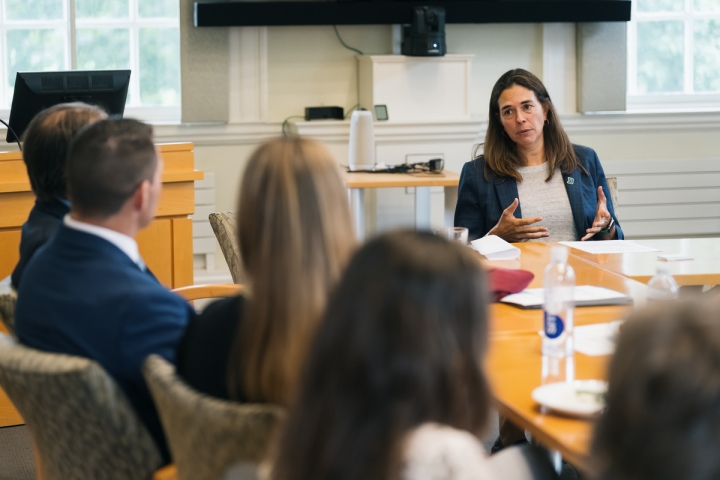A dozen leaders from the Community College System of New Hampshire traveled to Dartmouth last week to discuss their mutual goals and explore potential partnerships.
The meeting on Friday was prompted by Dartmouth’s interest in deepening its engagement with the broader community, President Sian Leah Beilock said.
Working with the community college system on research and teaching collaborations, supporting students and employees, and bringing cultural enrichment and other activities to the region is very important, said President Beilock, addressing the group in the Dartmouth Center for the Advancement of Learning conference room in Baker Library.
“We want to hear from you and learn from you and then figure out where there are points of collaboration,” she said.
The half-day gathering kicked off with quick overviews of each of the institutions. Charles Lloyd, vice chancellor and interim president at Manchester Community College, said the system’s 21,000 learners include about 10,000 dual-enrolled high school students, and highlighted some of the most popular fields of study, such as health care.

“A lot of what we try to do is build programming … to serve the industry and state and respond to the workforce there,” Lloyd said. “We also focus heavily on transfer pathways. … A lot of our students will start with us and transfer on within the university system.”
Conversations throughout the morning and over lunch identified many possibilities for collaboration.
A discussion facilitated by Provost David Kotz ’86 explored how leveraging the strengths of multiple institutions could enhance educational and research opportunities for students, professional development for employees, and access to Dartmouth resources such as libraries and laboratories.
In some cases, collaboration could be as simple as sharing expertise. The community college system might benefit from talking with Dartmouth staff about cybersecurity strategies, said Barbara Spada, chief information officer for CCSNH.
Or it could involve long-term projects. Several people gave examples of how teaming up to secure grants could be beneficial. Dartmouth could better argue for federal funding for a clean room for semiconductors and material science if it were also used by the community colleges and local business startups, Kotz said.
Lesley Nesbitt, program director of the EDGE Consortium, described the consortium’s efforts to diversify and strengthen the semiconductor workforce, such as training “nondegree track” workers and developing pedagogical reforms to encourage student retention in science, technology, engineering, and math courses.
Beilock co-founded the EDGE Consortium last year to help bring more women and underrepresented groups into careers in the semiconductor industry.
When it comes to creating better, more inclusive instructional models, “community colleges have a lot to teach us,” Nesbitt said.
Other suggested areas for partnership included shared training for faculty and staff, opportunities for community college students to work with Dartmouth researchers, and arts initiatives.
“The energy around exploring collaborations that will benefit all of our students and staff was so exciting,” organizer Heather Drinan, Dartmouth’s director of state government relations and community outreach, said after the meeting. “I expect we will see some immediate connections such as expanding Dartmouth’s Employee Resource Networks to include the CCSNH population, as well as many longer term institutional impacts like joint research projects.” The day wrapped up with a tour of Baker Tower, led by Drinan.


